Marketing Report: Analysis of Techniques, Research, Targeting, and Mix
VerifiedAdded on 2019/12/28
|11
|3051
|347
Report
AI Summary
This report provides an overview of marketing principles, techniques, and research methodologies, using Tesco and Apple as examples. It examines various marketing techniques like positioning, cause marketing, and guerrilla marketing, comparing their applications and limitations. The report delves into the use of marketing research for market planning, including brand awareness and customer acquisition, while also addressing its limitations such as unpredictable behavior and bias. Recommendations are offered to improve marketing research, focusing on asking specific questions and ensuring the sample matches the target audience. Finally, it explores the targeting of consumer groups and discusses the marketing mix for a new product or service, considering the target audience and market planning.
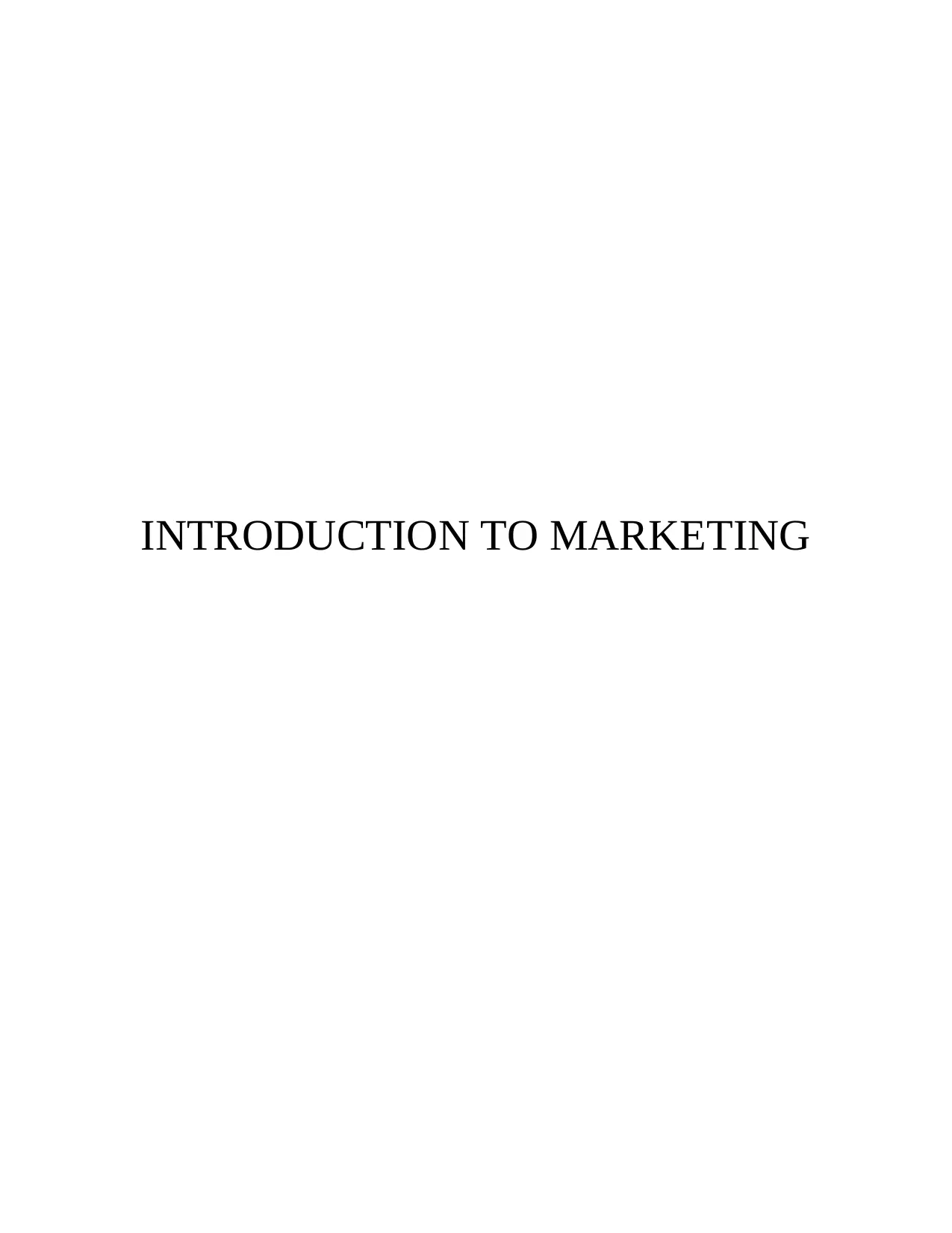
INTRODUCTION TO MARKETING
Paraphrase This Document
Need a fresh take? Get an instant paraphrase of this document with our AI Paraphraser
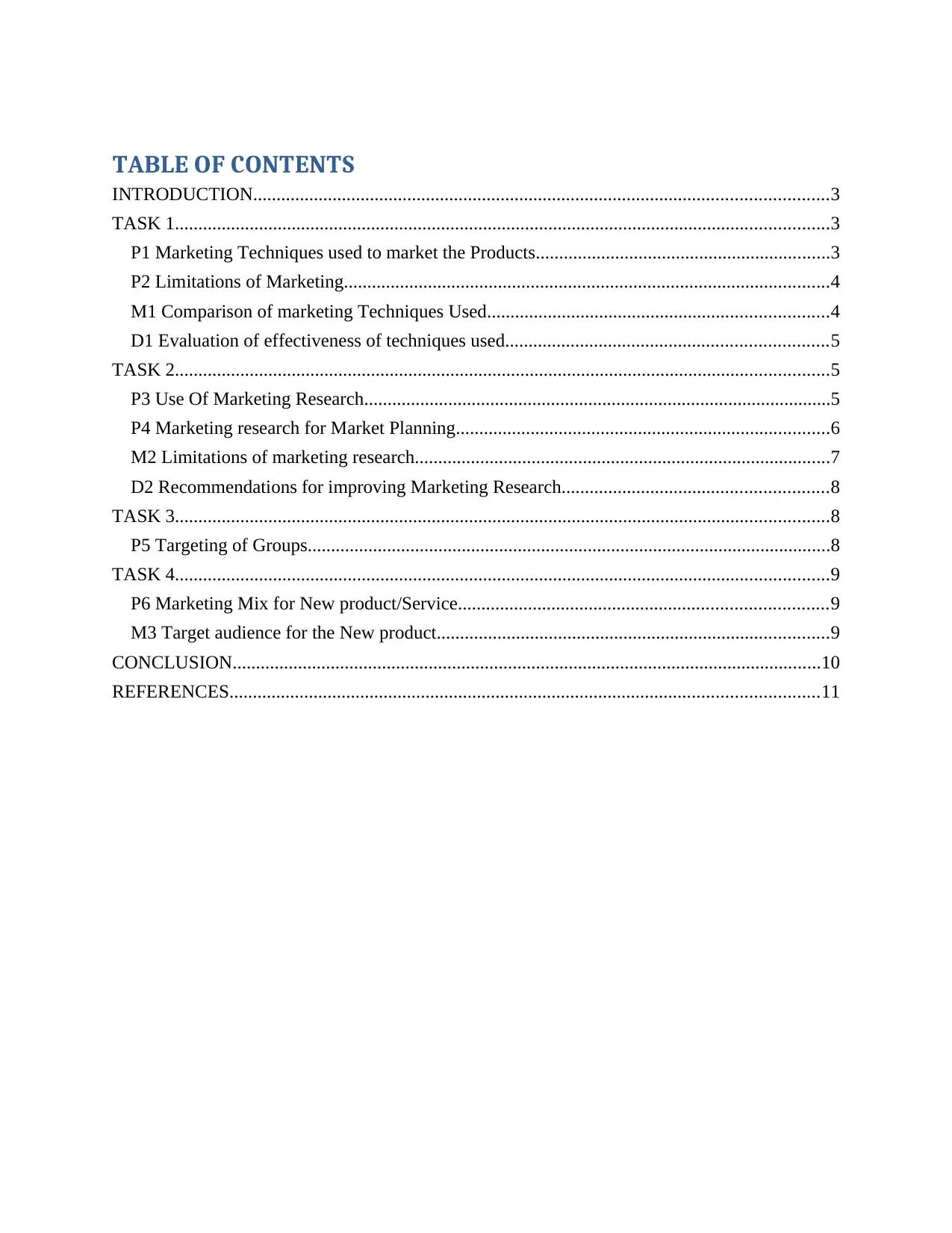
TABLE OF CONTENTS
INTRODUCTION...........................................................................................................................3
TASK 1............................................................................................................................................3
P1 Marketing Techniques used to market the Products...............................................................3
P2 Limitations of Marketing........................................................................................................4
M1 Comparison of marketing Techniques Used.........................................................................4
D1 Evaluation of effectiveness of techniques used.....................................................................5
TASK 2............................................................................................................................................5
P3 Use Of Marketing Research....................................................................................................5
P4 Marketing research for Market Planning................................................................................6
M2 Limitations of marketing research.........................................................................................7
D2 Recommendations for improving Marketing Research.........................................................8
TASK 3............................................................................................................................................8
P5 Targeting of Groups................................................................................................................8
TASK 4............................................................................................................................................9
P6 Marketing Mix for New product/Service...............................................................................9
M3 Target audience for the New product....................................................................................9
CONCLUSION..............................................................................................................................10
REFERENCES..............................................................................................................................11
INTRODUCTION...........................................................................................................................3
TASK 1............................................................................................................................................3
P1 Marketing Techniques used to market the Products...............................................................3
P2 Limitations of Marketing........................................................................................................4
M1 Comparison of marketing Techniques Used.........................................................................4
D1 Evaluation of effectiveness of techniques used.....................................................................5
TASK 2............................................................................................................................................5
P3 Use Of Marketing Research....................................................................................................5
P4 Marketing research for Market Planning................................................................................6
M2 Limitations of marketing research.........................................................................................7
D2 Recommendations for improving Marketing Research.........................................................8
TASK 3............................................................................................................................................8
P5 Targeting of Groups................................................................................................................8
TASK 4............................................................................................................................................9
P6 Marketing Mix for New product/Service...............................................................................9
M3 Target audience for the New product....................................................................................9
CONCLUSION..............................................................................................................................10
REFERENCES..............................................................................................................................11
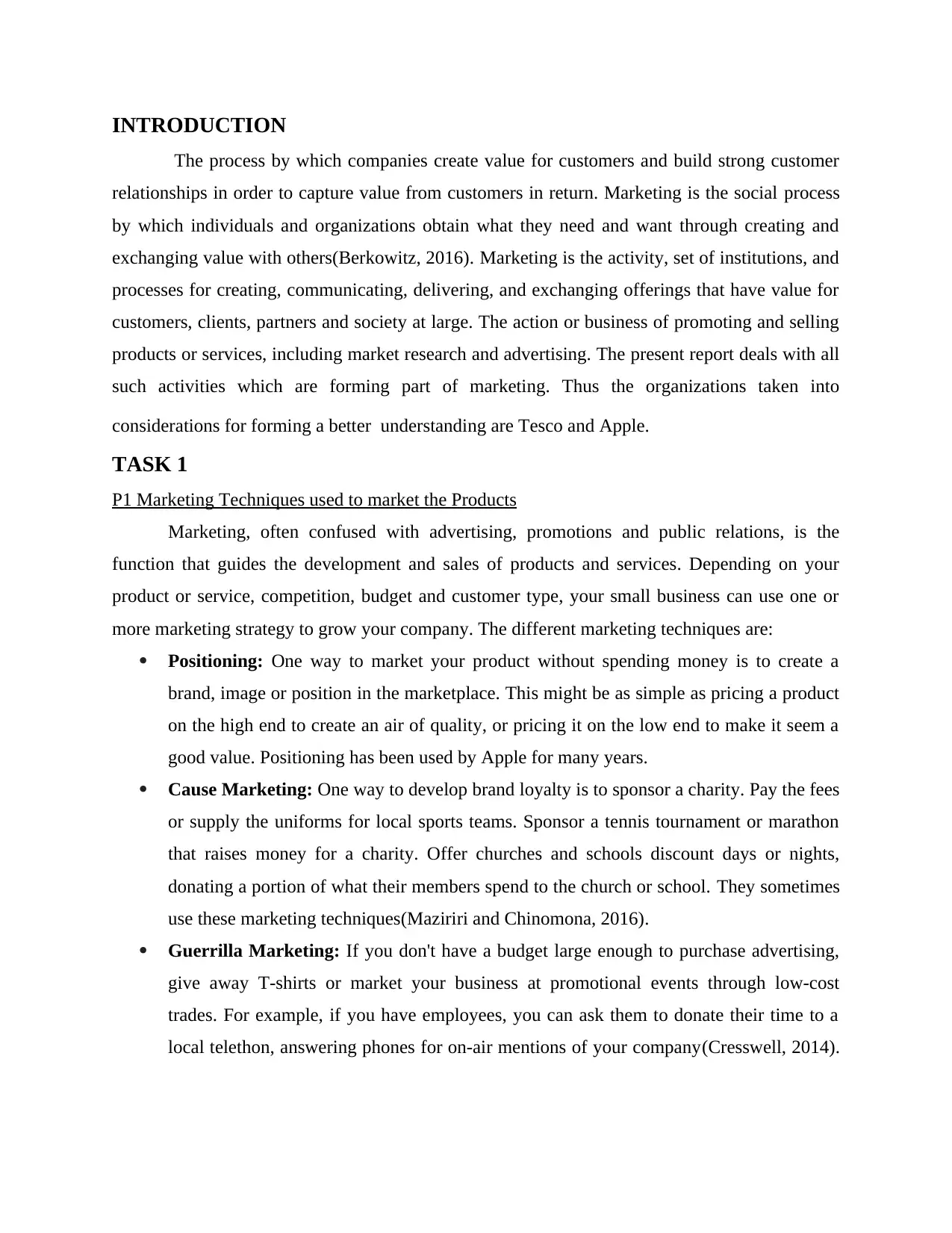
INTRODUCTION
The process by which companies create value for customers and build strong customer
relationships in order to capture value from customers in return. Marketing is the social process
by which individuals and organizations obtain what they need and want through creating and
exchanging value with others(Berkowitz, 2016). Marketing is the activity, set of institutions, and
processes for creating, communicating, delivering, and exchanging offerings that have value for
customers, clients, partners and society at large. The action or business of promoting and selling
products or services, including market research and advertising. The present report deals with all
such activities which are forming part of marketing. Thus the organizations taken into
considerations for forming a better understanding are Tesco and Apple.
TASK 1
P1 Marketing Techniques used to market the Products
Marketing, often confused with advertising, promotions and public relations, is the
function that guides the development and sales of products and services. Depending on your
product or service, competition, budget and customer type, your small business can use one or
more marketing strategy to grow your company. The different marketing techniques are:
Positioning: One way to market your product without spending money is to create a
brand, image or position in the marketplace. This might be as simple as pricing a product
on the high end to create an air of quality, or pricing it on the low end to make it seem a
good value. Positioning has been used by Apple for many years.
Cause Marketing: One way to develop brand loyalty is to sponsor a charity. Pay the fees
or supply the uniforms for local sports teams. Sponsor a tennis tournament or marathon
that raises money for a charity. Offer churches and schools discount days or nights,
donating a portion of what their members spend to the church or school. They sometimes
use these marketing techniques(Maziriri and Chinomona, 2016).
Guerrilla Marketing: If you don't have a budget large enough to purchase advertising,
give away T-shirts or market your business at promotional events through low-cost
trades. For example, if you have employees, you can ask them to donate their time to a
local telethon, answering phones for on-air mentions of your company(Cresswell, 2014).
The process by which companies create value for customers and build strong customer
relationships in order to capture value from customers in return. Marketing is the social process
by which individuals and organizations obtain what they need and want through creating and
exchanging value with others(Berkowitz, 2016). Marketing is the activity, set of institutions, and
processes for creating, communicating, delivering, and exchanging offerings that have value for
customers, clients, partners and society at large. The action or business of promoting and selling
products or services, including market research and advertising. The present report deals with all
such activities which are forming part of marketing. Thus the organizations taken into
considerations for forming a better understanding are Tesco and Apple.
TASK 1
P1 Marketing Techniques used to market the Products
Marketing, often confused with advertising, promotions and public relations, is the
function that guides the development and sales of products and services. Depending on your
product or service, competition, budget and customer type, your small business can use one or
more marketing strategy to grow your company. The different marketing techniques are:
Positioning: One way to market your product without spending money is to create a
brand, image or position in the marketplace. This might be as simple as pricing a product
on the high end to create an air of quality, or pricing it on the low end to make it seem a
good value. Positioning has been used by Apple for many years.
Cause Marketing: One way to develop brand loyalty is to sponsor a charity. Pay the fees
or supply the uniforms for local sports teams. Sponsor a tennis tournament or marathon
that raises money for a charity. Offer churches and schools discount days or nights,
donating a portion of what their members spend to the church or school. They sometimes
use these marketing techniques(Maziriri and Chinomona, 2016).
Guerrilla Marketing: If you don't have a budget large enough to purchase advertising,
give away T-shirts or market your business at promotional events through low-cost
trades. For example, if you have employees, you can ask them to donate their time to a
local telethon, answering phones for on-air mentions of your company(Cresswell, 2014).
⊘ This is a preview!⊘
Do you want full access?
Subscribe today to unlock all pages.

Trusted by 1+ million students worldwide
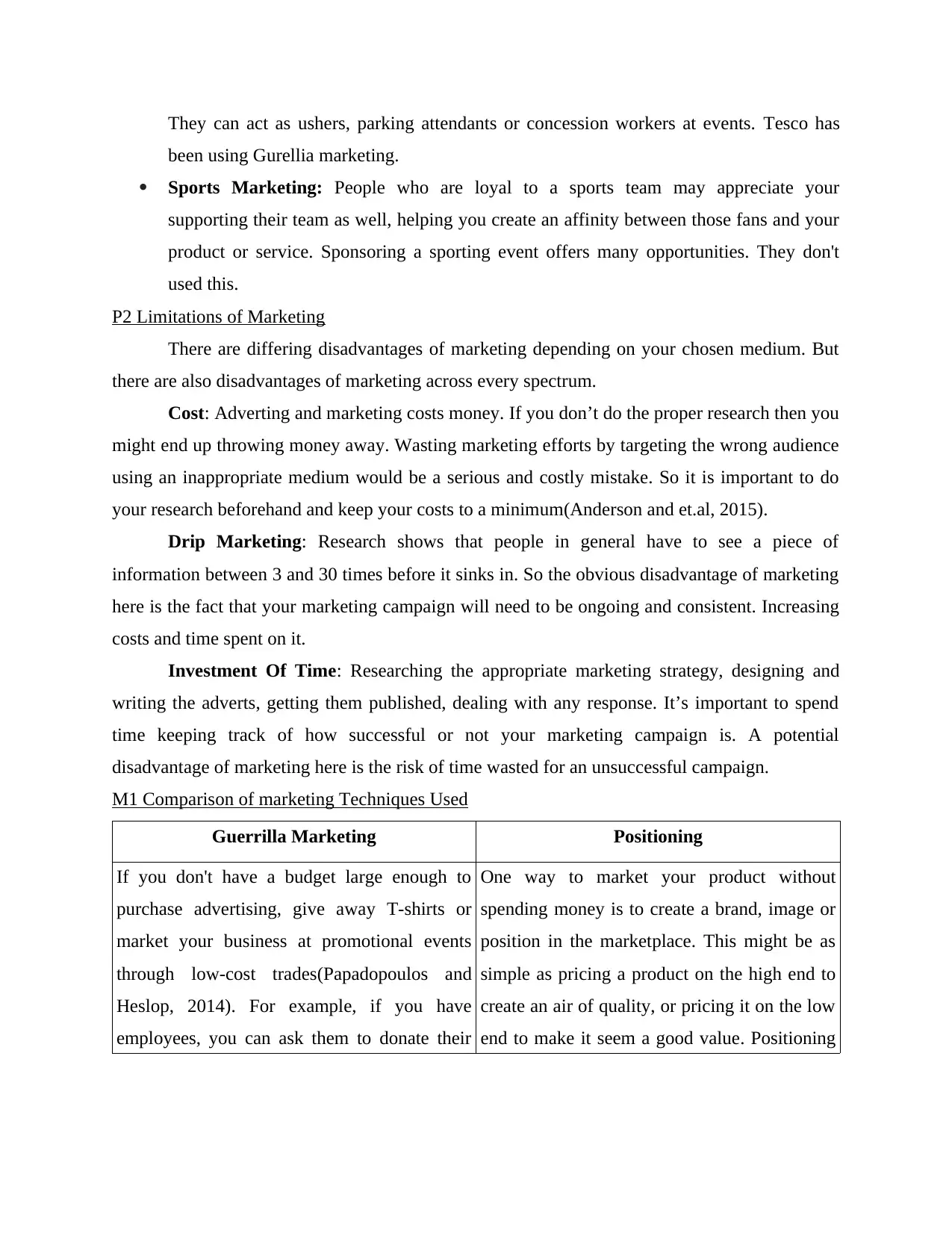
They can act as ushers, parking attendants or concession workers at events. Tesco has
been using Gurellia marketing.
Sports Marketing: People who are loyal to a sports team may appreciate your
supporting their team as well, helping you create an affinity between those fans and your
product or service. Sponsoring a sporting event offers many opportunities. They don't
used this.
P2 Limitations of Marketing
There are differing disadvantages of marketing depending on your chosen medium. But
there are also disadvantages of marketing across every spectrum.
Cost: Adverting and marketing costs money. If you don’t do the proper research then you
might end up throwing money away. Wasting marketing efforts by targeting the wrong audience
using an inappropriate medium would be a serious and costly mistake. So it is important to do
your research beforehand and keep your costs to a minimum(Anderson and et.al, 2015).
Drip Marketing: Research shows that people in general have to see a piece of
information between 3 and 30 times before it sinks in. So the obvious disadvantage of marketing
here is the fact that your marketing campaign will need to be ongoing and consistent. Increasing
costs and time spent on it.
Investment Of Time: Researching the appropriate marketing strategy, designing and
writing the adverts, getting them published, dealing with any response. It’s important to spend
time keeping track of how successful or not your marketing campaign is. A potential
disadvantage of marketing here is the risk of time wasted for an unsuccessful campaign.
M1 Comparison of marketing Techniques Used
Guerrilla Marketing Positioning
If you don't have a budget large enough to
purchase advertising, give away T-shirts or
market your business at promotional events
through low-cost trades(Papadopoulos and
Heslop, 2014). For example, if you have
employees, you can ask them to donate their
One way to market your product without
spending money is to create a brand, image or
position in the marketplace. This might be as
simple as pricing a product on the high end to
create an air of quality, or pricing it on the low
end to make it seem a good value. Positioning
been using Gurellia marketing.
Sports Marketing: People who are loyal to a sports team may appreciate your
supporting their team as well, helping you create an affinity between those fans and your
product or service. Sponsoring a sporting event offers many opportunities. They don't
used this.
P2 Limitations of Marketing
There are differing disadvantages of marketing depending on your chosen medium. But
there are also disadvantages of marketing across every spectrum.
Cost: Adverting and marketing costs money. If you don’t do the proper research then you
might end up throwing money away. Wasting marketing efforts by targeting the wrong audience
using an inappropriate medium would be a serious and costly mistake. So it is important to do
your research beforehand and keep your costs to a minimum(Anderson and et.al, 2015).
Drip Marketing: Research shows that people in general have to see a piece of
information between 3 and 30 times before it sinks in. So the obvious disadvantage of marketing
here is the fact that your marketing campaign will need to be ongoing and consistent. Increasing
costs and time spent on it.
Investment Of Time: Researching the appropriate marketing strategy, designing and
writing the adverts, getting them published, dealing with any response. It’s important to spend
time keeping track of how successful or not your marketing campaign is. A potential
disadvantage of marketing here is the risk of time wasted for an unsuccessful campaign.
M1 Comparison of marketing Techniques Used
Guerrilla Marketing Positioning
If you don't have a budget large enough to
purchase advertising, give away T-shirts or
market your business at promotional events
through low-cost trades(Papadopoulos and
Heslop, 2014). For example, if you have
employees, you can ask them to donate their
One way to market your product without
spending money is to create a brand, image or
position in the marketplace. This might be as
simple as pricing a product on the high end to
create an air of quality, or pricing it on the low
end to make it seem a good value. Positioning
Paraphrase This Document
Need a fresh take? Get an instant paraphrase of this document with our AI Paraphraser
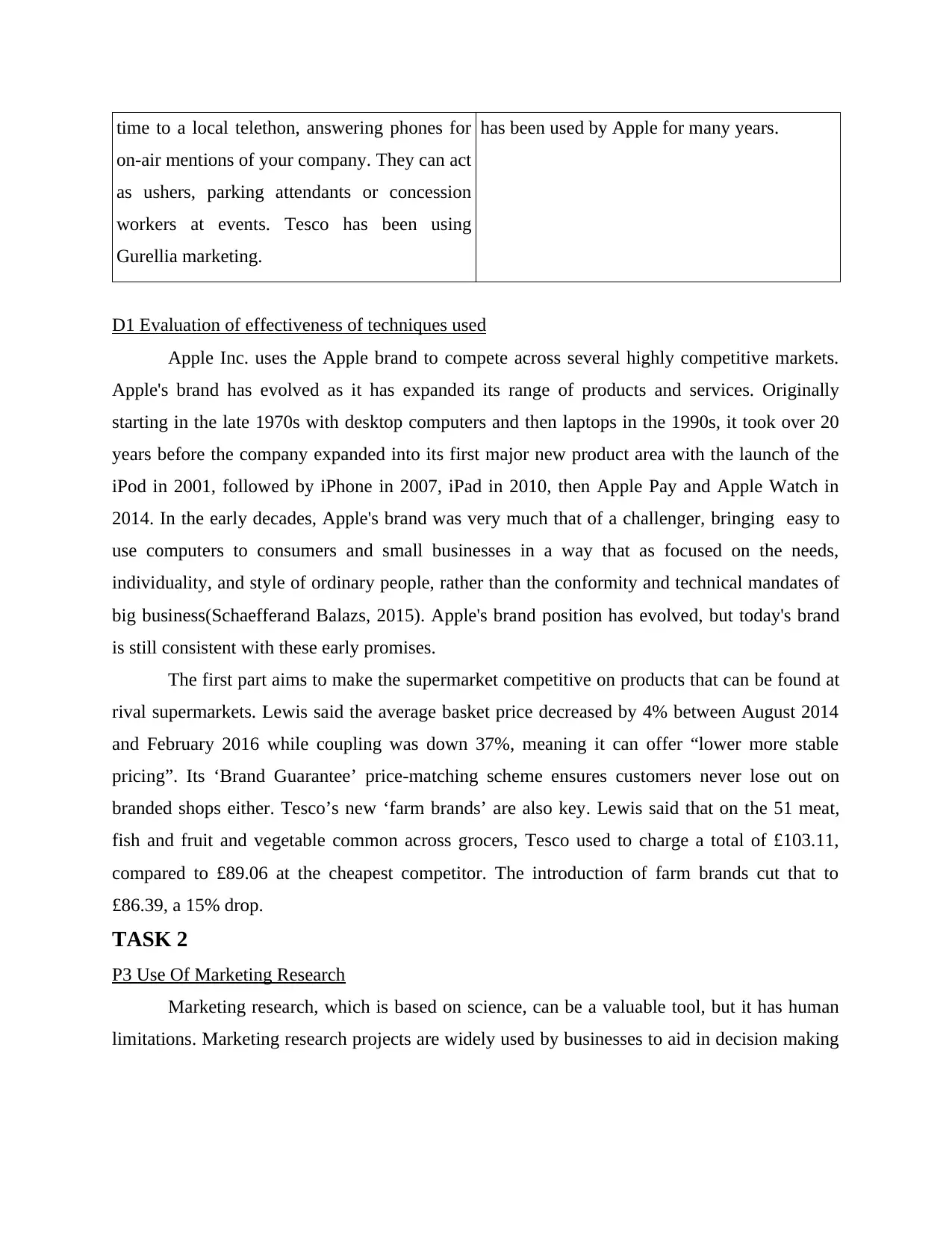
time to a local telethon, answering phones for
on-air mentions of your company. They can act
as ushers, parking attendants or concession
workers at events. Tesco has been using
Gurellia marketing.
has been used by Apple for many years.
D1 Evaluation of effectiveness of techniques used
Apple Inc. uses the Apple brand to compete across several highly competitive markets.
Apple's brand has evolved as it has expanded its range of products and services. Originally
starting in the late 1970s with desktop computers and then laptops in the 1990s, it took over 20
years before the company expanded into its first major new product area with the launch of the
iPod in 2001, followed by iPhone in 2007, iPad in 2010, then Apple Pay and Apple Watch in
2014. In the early decades, Apple's brand was very much that of a challenger, bringing easy to
use computers to consumers and small businesses in a way that as focused on the needs,
individuality, and style of ordinary people, rather than the conformity and technical mandates of
big business(Schaefferand Balazs, 2015). Apple's brand position has evolved, but today's brand
is still consistent with these early promises.
The first part aims to make the supermarket competitive on products that can be found at
rival supermarkets. Lewis said the average basket price decreased by 4% between August 2014
and February 2016 while coupling was down 37%, meaning it can offer “lower more stable
pricing”. Its ‘Brand Guarantee’ price-matching scheme ensures customers never lose out on
branded shops either. Tesco’s new ‘farm brands’ are also key. Lewis said that on the 51 meat,
fish and fruit and vegetable common across grocers, Tesco used to charge a total of £103.11,
compared to £89.06 at the cheapest competitor. The introduction of farm brands cut that to
£86.39, a 15% drop.
TASK 2
P3 Use Of Marketing Research
Marketing research, which is based on science, can be a valuable tool, but it has human
limitations. Marketing research projects are widely used by businesses to aid in decision making
on-air mentions of your company. They can act
as ushers, parking attendants or concession
workers at events. Tesco has been using
Gurellia marketing.
has been used by Apple for many years.
D1 Evaluation of effectiveness of techniques used
Apple Inc. uses the Apple brand to compete across several highly competitive markets.
Apple's brand has evolved as it has expanded its range of products and services. Originally
starting in the late 1970s with desktop computers and then laptops in the 1990s, it took over 20
years before the company expanded into its first major new product area with the launch of the
iPod in 2001, followed by iPhone in 2007, iPad in 2010, then Apple Pay and Apple Watch in
2014. In the early decades, Apple's brand was very much that of a challenger, bringing easy to
use computers to consumers and small businesses in a way that as focused on the needs,
individuality, and style of ordinary people, rather than the conformity and technical mandates of
big business(Schaefferand Balazs, 2015). Apple's brand position has evolved, but today's brand
is still consistent with these early promises.
The first part aims to make the supermarket competitive on products that can be found at
rival supermarkets. Lewis said the average basket price decreased by 4% between August 2014
and February 2016 while coupling was down 37%, meaning it can offer “lower more stable
pricing”. Its ‘Brand Guarantee’ price-matching scheme ensures customers never lose out on
branded shops either. Tesco’s new ‘farm brands’ are also key. Lewis said that on the 51 meat,
fish and fruit and vegetable common across grocers, Tesco used to charge a total of £103.11,
compared to £89.06 at the cheapest competitor. The introduction of farm brands cut that to
£86.39, a 15% drop.
TASK 2
P3 Use Of Marketing Research
Marketing research, which is based on science, can be a valuable tool, but it has human
limitations. Marketing research projects are widely used by businesses to aid in decision making
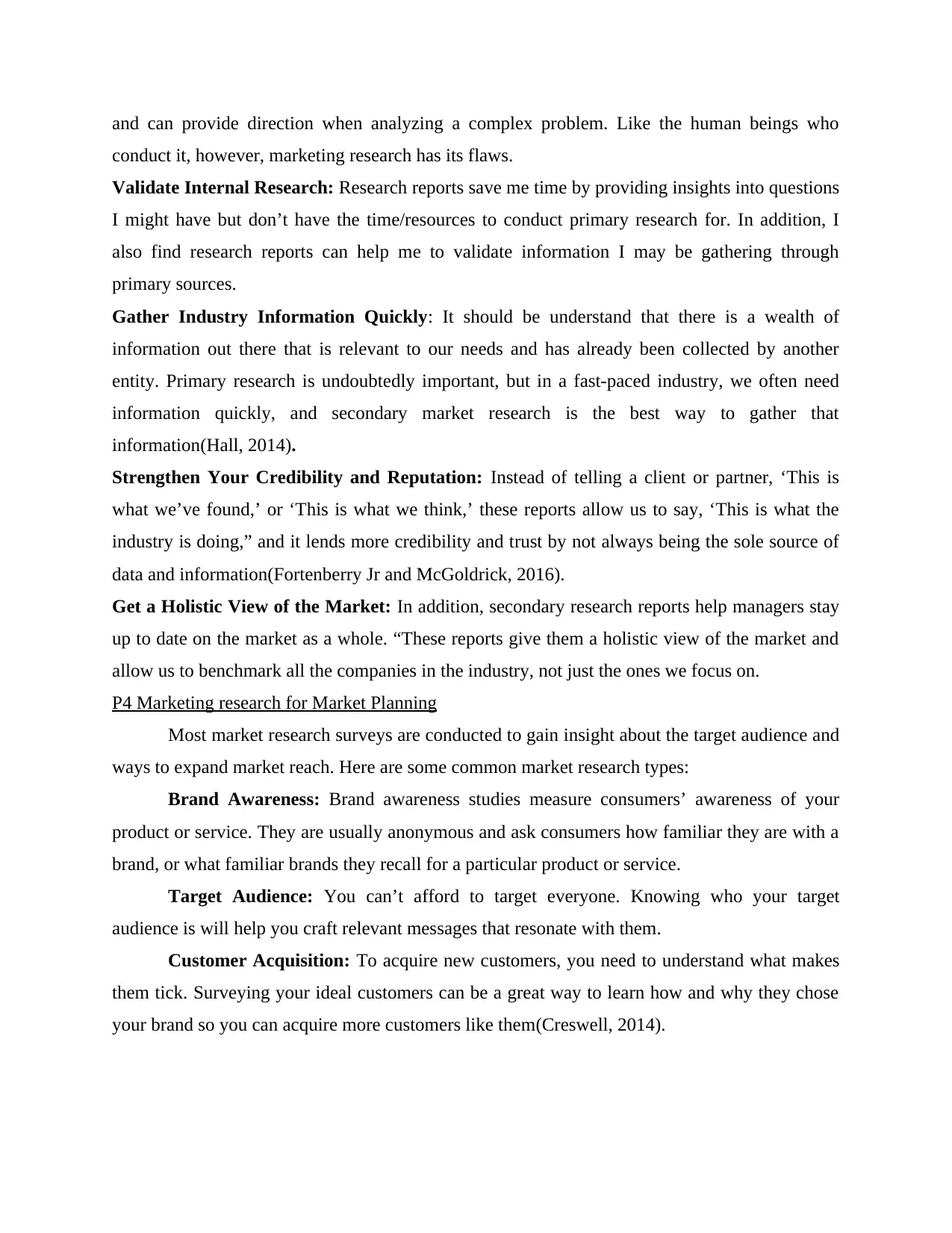
and can provide direction when analyzing a complex problem. Like the human beings who
conduct it, however, marketing research has its flaws.
Validate Internal Research: Research reports save me time by providing insights into questions
I might have but don’t have the time/resources to conduct primary research for. In addition, I
also find research reports can help me to validate information I may be gathering through
primary sources.
Gather Industry Information Quickly: It should be understand that there is a wealth of
information out there that is relevant to our needs and has already been collected by another
entity. Primary research is undoubtedly important, but in a fast-paced industry, we often need
information quickly, and secondary market research is the best way to gather that
information(Hall, 2014).
Strengthen Your Credibility and Reputation: Instead of telling a client or partner, ‘This is
what we’ve found,’ or ‘This is what we think,’ these reports allow us to say, ‘This is what the
industry is doing,” and it lends more credibility and trust by not always being the sole source of
data and information(Fortenberry Jr and McGoldrick, 2016).
Get a Holistic View of the Market: In addition, secondary research reports help managers stay
up to date on the market as a whole. “These reports give them a holistic view of the market and
allow us to benchmark all the companies in the industry, not just the ones we focus on.
P4 Marketing research for Market Planning
Most market research surveys are conducted to gain insight about the target audience and
ways to expand market reach. Here are some common market research types:
Brand Awareness: Brand awareness studies measure consumers’ awareness of your
product or service. They are usually anonymous and ask consumers how familiar they are with a
brand, or what familiar brands they recall for a particular product or service.
Target Audience: You can’t afford to target everyone. Knowing who your target
audience is will help you craft relevant messages that resonate with them.
Customer Acquisition: To acquire new customers, you need to understand what makes
them tick. Surveying your ideal customers can be a great way to learn how and why they chose
your brand so you can acquire more customers like them(Creswell, 2014).
conduct it, however, marketing research has its flaws.
Validate Internal Research: Research reports save me time by providing insights into questions
I might have but don’t have the time/resources to conduct primary research for. In addition, I
also find research reports can help me to validate information I may be gathering through
primary sources.
Gather Industry Information Quickly: It should be understand that there is a wealth of
information out there that is relevant to our needs and has already been collected by another
entity. Primary research is undoubtedly important, but in a fast-paced industry, we often need
information quickly, and secondary market research is the best way to gather that
information(Hall, 2014).
Strengthen Your Credibility and Reputation: Instead of telling a client or partner, ‘This is
what we’ve found,’ or ‘This is what we think,’ these reports allow us to say, ‘This is what the
industry is doing,” and it lends more credibility and trust by not always being the sole source of
data and information(Fortenberry Jr and McGoldrick, 2016).
Get a Holistic View of the Market: In addition, secondary research reports help managers stay
up to date on the market as a whole. “These reports give them a holistic view of the market and
allow us to benchmark all the companies in the industry, not just the ones we focus on.
P4 Marketing research for Market Planning
Most market research surveys are conducted to gain insight about the target audience and
ways to expand market reach. Here are some common market research types:
Brand Awareness: Brand awareness studies measure consumers’ awareness of your
product or service. They are usually anonymous and ask consumers how familiar they are with a
brand, or what familiar brands they recall for a particular product or service.
Target Audience: You can’t afford to target everyone. Knowing who your target
audience is will help you craft relevant messages that resonate with them.
Customer Acquisition: To acquire new customers, you need to understand what makes
them tick. Surveying your ideal customers can be a great way to learn how and why they chose
your brand so you can acquire more customers like them(Creswell, 2014).
⊘ This is a preview!⊘
Do you want full access?
Subscribe today to unlock all pages.

Trusted by 1+ million students worldwide
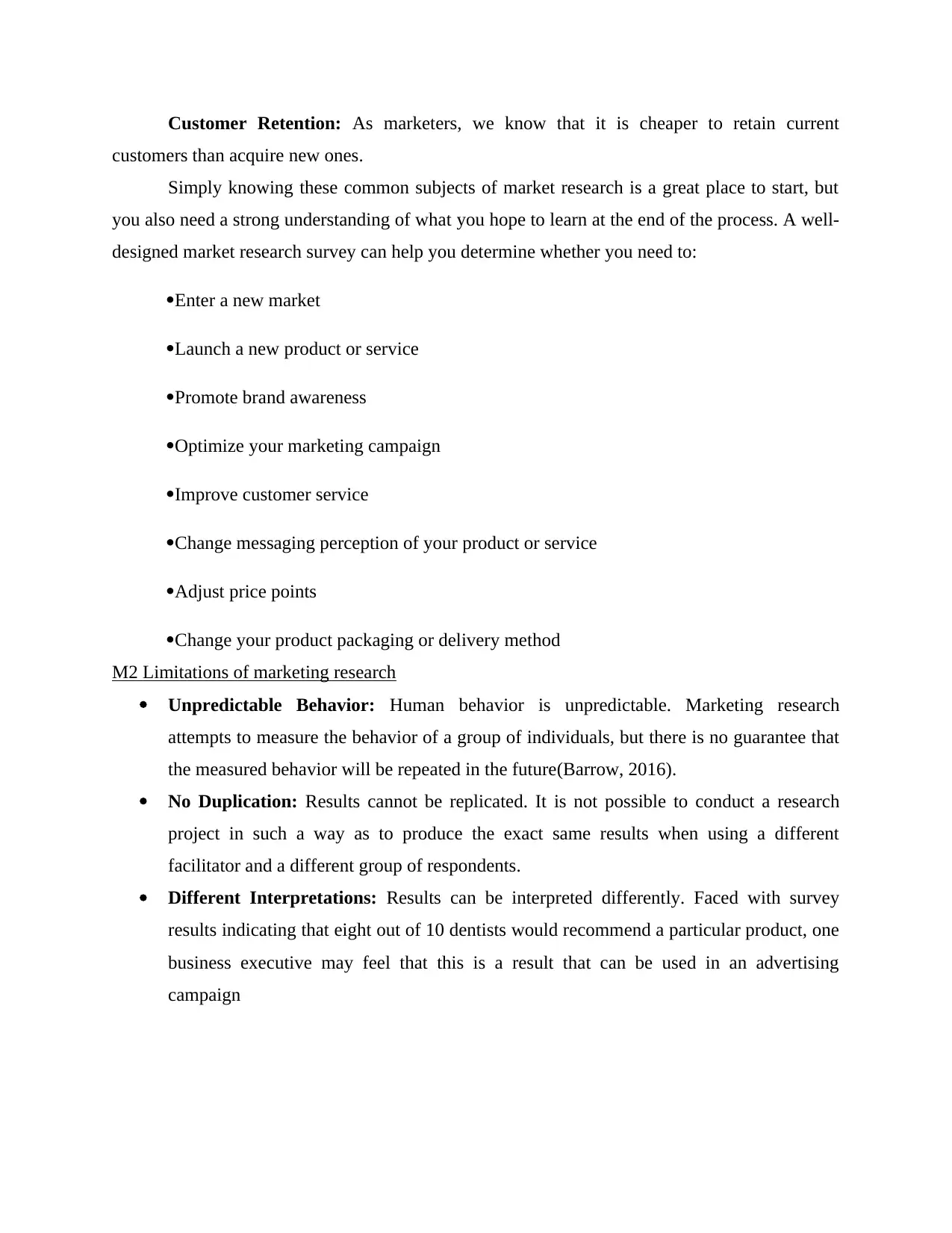
Customer Retention: As marketers, we know that it is cheaper to retain current
customers than acquire new ones.
Simply knowing these common subjects of market research is a great place to start, but
you also need a strong understanding of what you hope to learn at the end of the process. A well-
designed market research survey can help you determine whether you need to:
Enter a new market
Launch a new product or service
Promote brand awareness
Optimize your marketing campaign
Improve customer service
Change messaging perception of your product or service
Adjust price points
Change your product packaging or delivery method
M2 Limitations of marketing research
Unpredictable Behavior: Human behavior is unpredictable. Marketing research
attempts to measure the behavior of a group of individuals, but there is no guarantee that
the measured behavior will be repeated in the future(Barrow, 2016).
No Duplication: Results cannot be replicated. It is not possible to conduct a research
project in such a way as to produce the exact same results when using a different
facilitator and a different group of respondents.
Different Interpretations: Results can be interpreted differently. Faced with survey
results indicating that eight out of 10 dentists would recommend a particular product, one
business executive may feel that this is a result that can be used in an advertising
campaign
customers than acquire new ones.
Simply knowing these common subjects of market research is a great place to start, but
you also need a strong understanding of what you hope to learn at the end of the process. A well-
designed market research survey can help you determine whether you need to:
Enter a new market
Launch a new product or service
Promote brand awareness
Optimize your marketing campaign
Improve customer service
Change messaging perception of your product or service
Adjust price points
Change your product packaging or delivery method
M2 Limitations of marketing research
Unpredictable Behavior: Human behavior is unpredictable. Marketing research
attempts to measure the behavior of a group of individuals, but there is no guarantee that
the measured behavior will be repeated in the future(Barrow, 2016).
No Duplication: Results cannot be replicated. It is not possible to conduct a research
project in such a way as to produce the exact same results when using a different
facilitator and a different group of respondents.
Different Interpretations: Results can be interpreted differently. Faced with survey
results indicating that eight out of 10 dentists would recommend a particular product, one
business executive may feel that this is a result that can be used in an advertising
campaign
Paraphrase This Document
Need a fresh take? Get an instant paraphrase of this document with our AI Paraphraser
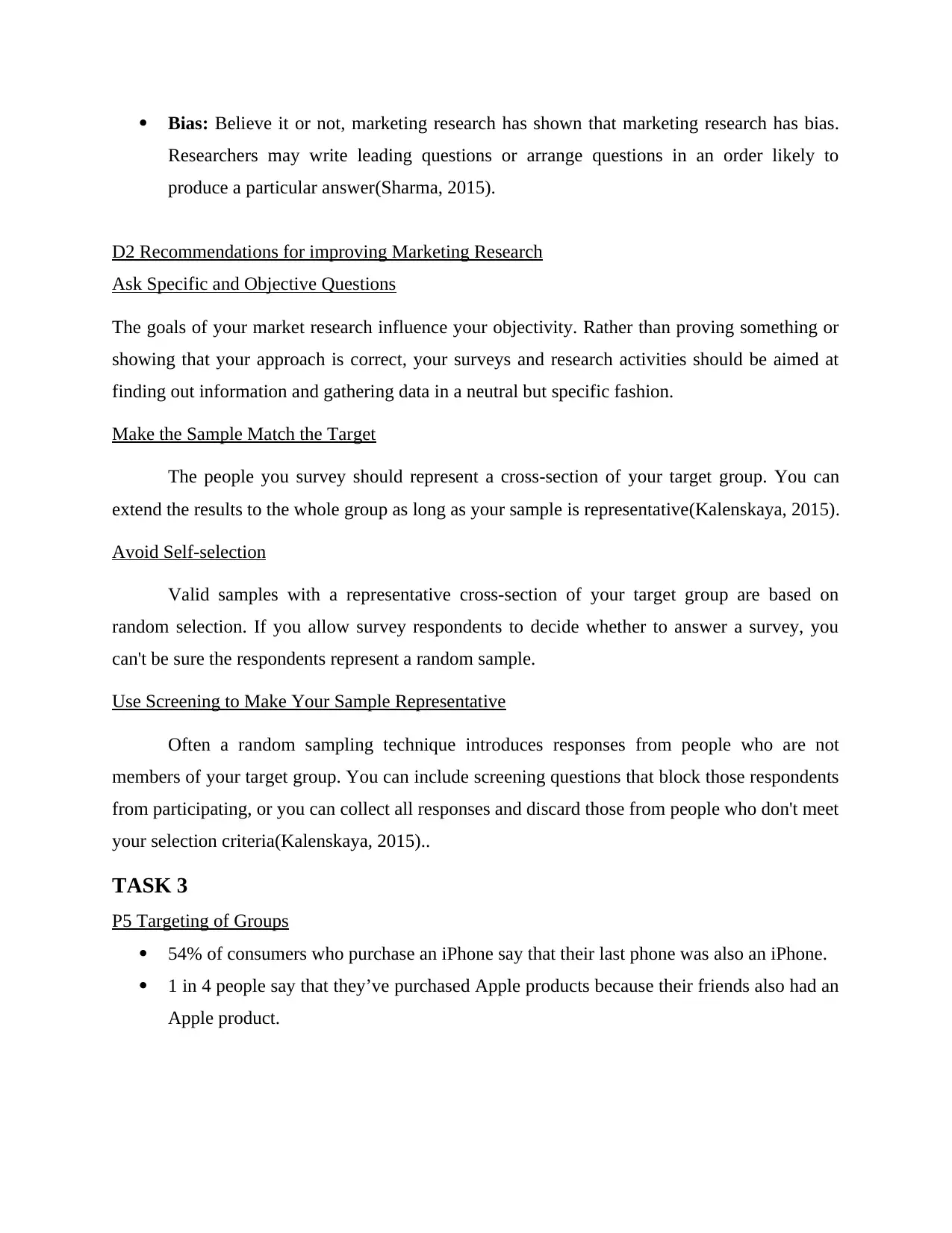
Bias: Believe it or not, marketing research has shown that marketing research has bias.
Researchers may write leading questions or arrange questions in an order likely to
produce a particular answer(Sharma, 2015).
D2 Recommendations for improving Marketing Research
Ask Specific and Objective Questions
The goals of your market research influence your objectivity. Rather than proving something or
showing that your approach is correct, your surveys and research activities should be aimed at
finding out information and gathering data in a neutral but specific fashion.
Make the Sample Match the Target
The people you survey should represent a cross-section of your target group. You can
extend the results to the whole group as long as your sample is representative(Kalenskaya, 2015).
Avoid Self-selection
Valid samples with a representative cross-section of your target group are based on
random selection. If you allow survey respondents to decide whether to answer a survey, you
can't be sure the respondents represent a random sample.
Use Screening to Make Your Sample Representative
Often a random sampling technique introduces responses from people who are not
members of your target group. You can include screening questions that block those respondents
from participating, or you can collect all responses and discard those from people who don't meet
your selection criteria(Kalenskaya, 2015)..
TASK 3
P5 Targeting of Groups
54% of consumers who purchase an iPhone say that their last phone was also an iPhone.
1 in 4 people say that they’ve purchased Apple products because their friends also had an
Apple product.
Researchers may write leading questions or arrange questions in an order likely to
produce a particular answer(Sharma, 2015).
D2 Recommendations for improving Marketing Research
Ask Specific and Objective Questions
The goals of your market research influence your objectivity. Rather than proving something or
showing that your approach is correct, your surveys and research activities should be aimed at
finding out information and gathering data in a neutral but specific fashion.
Make the Sample Match the Target
The people you survey should represent a cross-section of your target group. You can
extend the results to the whole group as long as your sample is representative(Kalenskaya, 2015).
Avoid Self-selection
Valid samples with a representative cross-section of your target group are based on
random selection. If you allow survey respondents to decide whether to answer a survey, you
can't be sure the respondents represent a random sample.
Use Screening to Make Your Sample Representative
Often a random sampling technique introduces responses from people who are not
members of your target group. You can include screening questions that block those respondents
from participating, or you can collect all responses and discard those from people who don't meet
your selection criteria(Kalenskaya, 2015)..
TASK 3
P5 Targeting of Groups
54% of consumers who purchase an iPhone say that their last phone was also an iPhone.
1 in 4 people say that they’ve purchased Apple products because their friends also had an
Apple product.
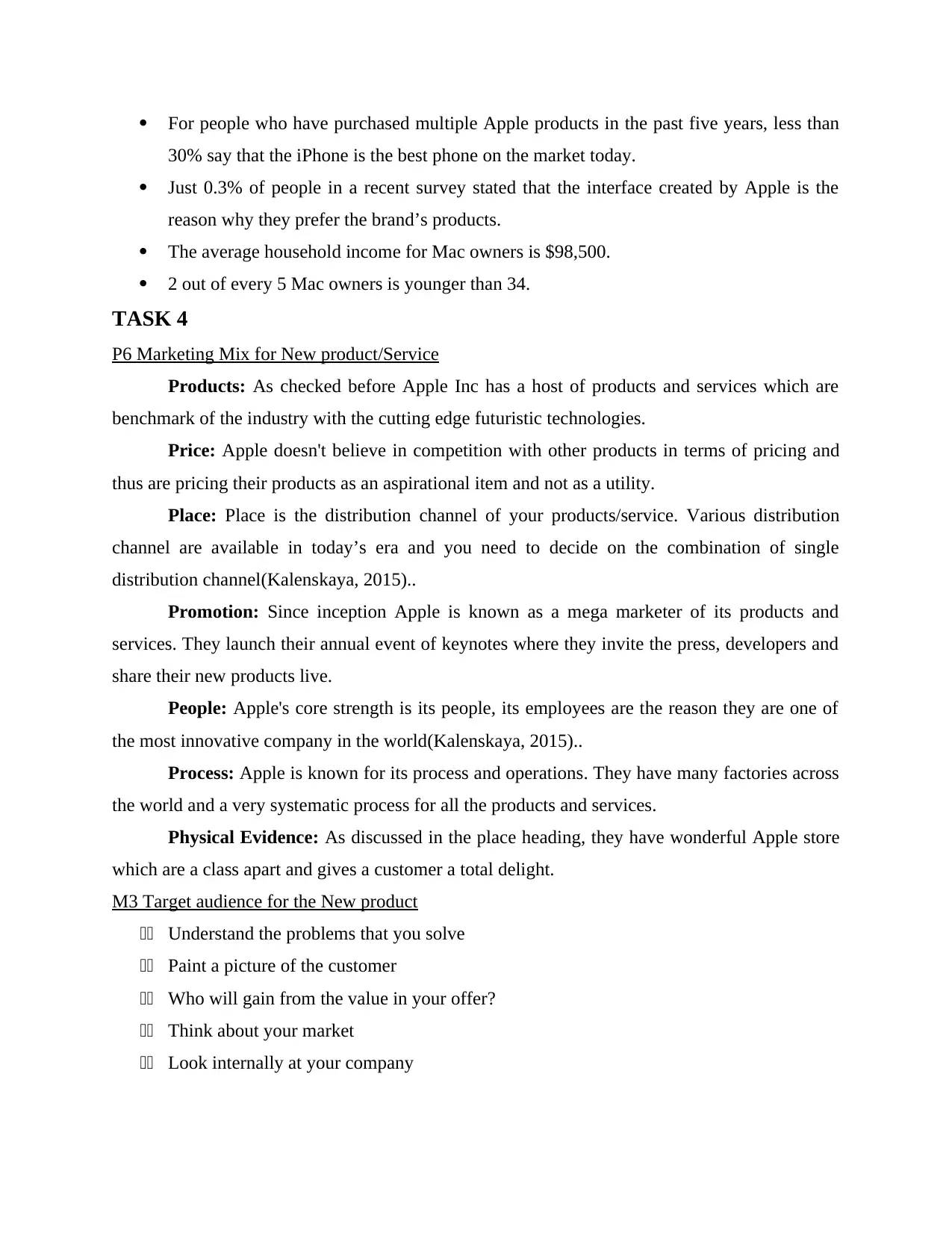
For people who have purchased multiple Apple products in the past five years, less than
30% say that the iPhone is the best phone on the market today.
Just 0.3% of people in a recent survey stated that the interface created by Apple is the
reason why they prefer the brand’s products.
The average household income for Mac owners is $98,500.
2 out of every 5 Mac owners is younger than 34.
TASK 4
P6 Marketing Mix for New product/Service
Products: As checked before Apple Inc has a host of products and services which are
benchmark of the industry with the cutting edge futuristic technologies.
Price: Apple doesn't believe in competition with other products in terms of pricing and
thus are pricing their products as an aspirational item and not as a utility.
Place: Place is the distribution channel of your products/service. Various distribution
channel are available in today’s era and you need to decide on the combination of single
distribution channel(Kalenskaya, 2015)..
Promotion: Since inception Apple is known as a mega marketer of its products and
services. They launch their annual event of keynotes where they invite the press, developers and
share their new products live.
People: Apple's core strength is its people, its employees are the reason they are one of
the most innovative company in the world(Kalenskaya, 2015)..
Process: Apple is known for its process and operations. They have many factories across
the world and a very systematic process for all the products and services.
Physical Evidence: As discussed in the place heading, they have wonderful Apple store
which are a class apart and gives a customer a total delight.
M3 Target audience for the New product
11 Understand the problems that you solve
11 Paint a picture of the customer
11 Who will gain from the value in your offer?
11 Think about your market
11 Look internally at your company
30% say that the iPhone is the best phone on the market today.
Just 0.3% of people in a recent survey stated that the interface created by Apple is the
reason why they prefer the brand’s products.
The average household income for Mac owners is $98,500.
2 out of every 5 Mac owners is younger than 34.
TASK 4
P6 Marketing Mix for New product/Service
Products: As checked before Apple Inc has a host of products and services which are
benchmark of the industry with the cutting edge futuristic technologies.
Price: Apple doesn't believe in competition with other products in terms of pricing and
thus are pricing their products as an aspirational item and not as a utility.
Place: Place is the distribution channel of your products/service. Various distribution
channel are available in today’s era and you need to decide on the combination of single
distribution channel(Kalenskaya, 2015)..
Promotion: Since inception Apple is known as a mega marketer of its products and
services. They launch their annual event of keynotes where they invite the press, developers and
share their new products live.
People: Apple's core strength is its people, its employees are the reason they are one of
the most innovative company in the world(Kalenskaya, 2015)..
Process: Apple is known for its process and operations. They have many factories across
the world and a very systematic process for all the products and services.
Physical Evidence: As discussed in the place heading, they have wonderful Apple store
which are a class apart and gives a customer a total delight.
M3 Target audience for the New product
11 Understand the problems that you solve
11 Paint a picture of the customer
11 Who will gain from the value in your offer?
11 Think about your market
11 Look internally at your company
⊘ This is a preview!⊘
Do you want full access?
Subscribe today to unlock all pages.

Trusted by 1+ million students worldwide
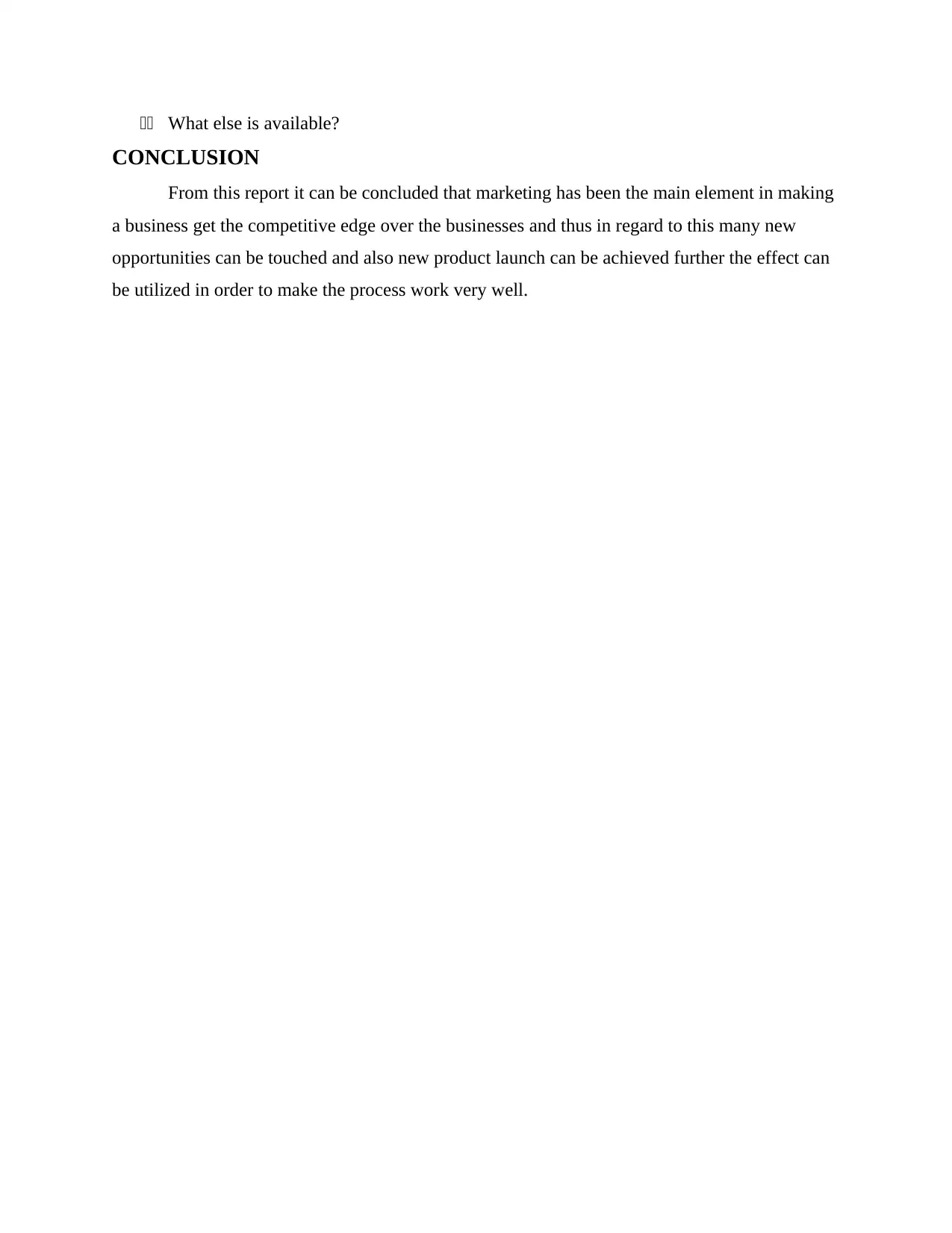
11 What else is available?
CONCLUSION
From this report it can be concluded that marketing has been the main element in making
a business get the competitive edge over the businesses and thus in regard to this many new
opportunities can be touched and also new product launch can be achieved further the effect can
be utilized in order to make the process work very well.
CONCLUSION
From this report it can be concluded that marketing has been the main element in making
a business get the competitive edge over the businesses and thus in regard to this many new
opportunities can be touched and also new product launch can be achieved further the effect can
be utilized in order to make the process work very well.
Paraphrase This Document
Need a fresh take? Get an instant paraphrase of this document with our AI Paraphraser
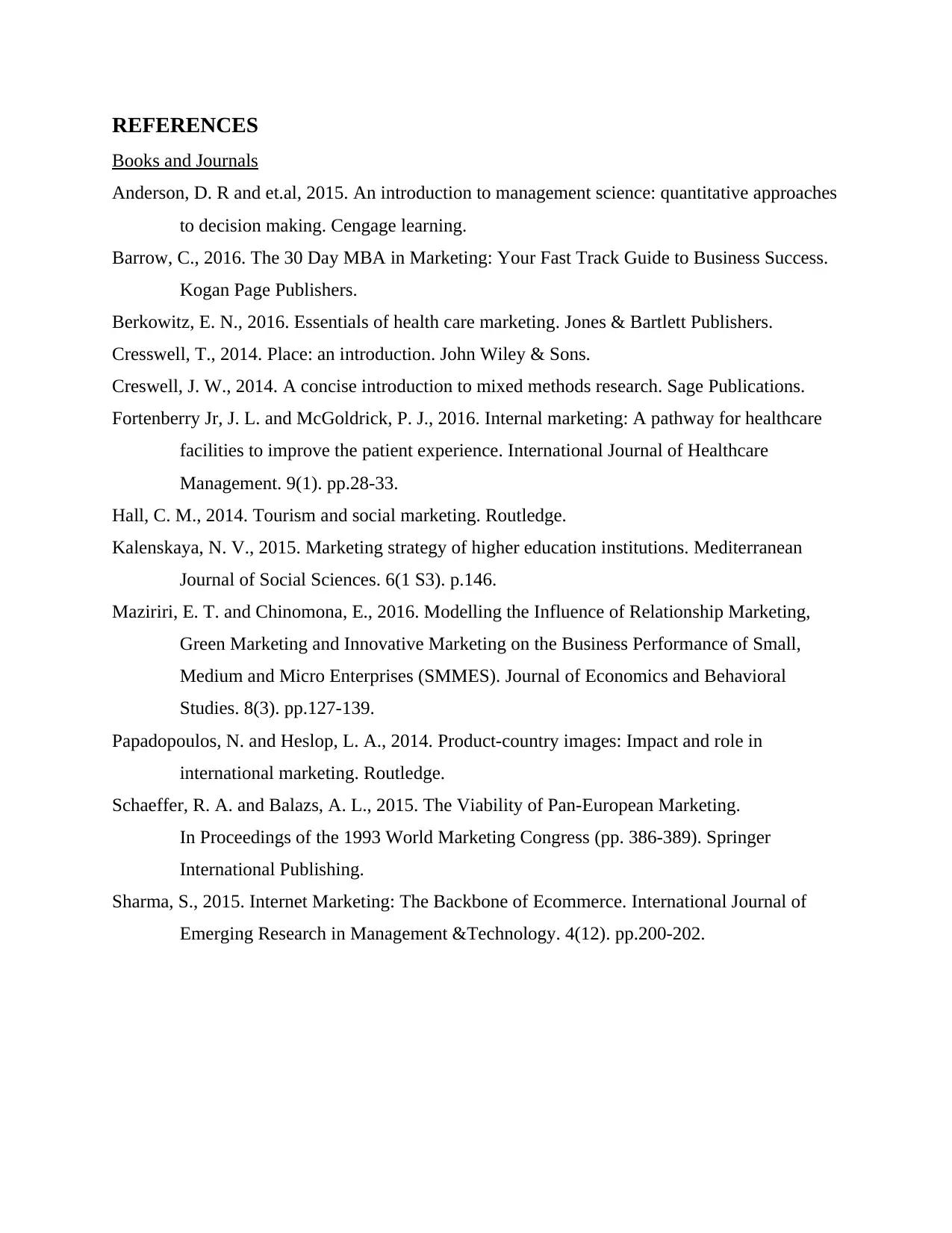
REFERENCES
Books and Journals
Anderson, D. R and et.al, 2015. An introduction to management science: quantitative approaches
to decision making. Cengage learning.
Barrow, C., 2016. The 30 Day MBA in Marketing: Your Fast Track Guide to Business Success.
Kogan Page Publishers.
Berkowitz, E. N., 2016. Essentials of health care marketing. Jones & Bartlett Publishers.
Cresswell, T., 2014. Place: an introduction. John Wiley & Sons.
Creswell, J. W., 2014. A concise introduction to mixed methods research. Sage Publications.
Fortenberry Jr, J. L. and McGoldrick, P. J., 2016. Internal marketing: A pathway for healthcare
facilities to improve the patient experience. International Journal of Healthcare
Management. 9(1). pp.28-33.
Hall, C. M., 2014. Tourism and social marketing. Routledge.
Kalenskaya, N. V., 2015. Marketing strategy of higher education institutions. Mediterranean
Journal of Social Sciences. 6(1 S3). p.146.
Maziriri, E. T. and Chinomona, E., 2016. Modelling the Influence of Relationship Marketing,
Green Marketing and Innovative Marketing on the Business Performance of Small,
Medium and Micro Enterprises (SMMES). Journal of Economics and Behavioral
Studies. 8(3). pp.127-139.
Papadopoulos, N. and Heslop, L. A., 2014. Product-country images: Impact and role in
international marketing. Routledge.
Schaeffer, R. A. and Balazs, A. L., 2015. The Viability of Pan-European Marketing.
In Proceedings of the 1993 World Marketing Congress (pp. 386-389). Springer
International Publishing.
Sharma, S., 2015. Internet Marketing: The Backbone of Ecommerce. International Journal of
Emerging Research in Management &Technology. 4(12). pp.200-202.
Books and Journals
Anderson, D. R and et.al, 2015. An introduction to management science: quantitative approaches
to decision making. Cengage learning.
Barrow, C., 2016. The 30 Day MBA in Marketing: Your Fast Track Guide to Business Success.
Kogan Page Publishers.
Berkowitz, E. N., 2016. Essentials of health care marketing. Jones & Bartlett Publishers.
Cresswell, T., 2014. Place: an introduction. John Wiley & Sons.
Creswell, J. W., 2014. A concise introduction to mixed methods research. Sage Publications.
Fortenberry Jr, J. L. and McGoldrick, P. J., 2016. Internal marketing: A pathway for healthcare
facilities to improve the patient experience. International Journal of Healthcare
Management. 9(1). pp.28-33.
Hall, C. M., 2014. Tourism and social marketing. Routledge.
Kalenskaya, N. V., 2015. Marketing strategy of higher education institutions. Mediterranean
Journal of Social Sciences. 6(1 S3). p.146.
Maziriri, E. T. and Chinomona, E., 2016. Modelling the Influence of Relationship Marketing,
Green Marketing and Innovative Marketing on the Business Performance of Small,
Medium and Micro Enterprises (SMMES). Journal of Economics and Behavioral
Studies. 8(3). pp.127-139.
Papadopoulos, N. and Heslop, L. A., 2014. Product-country images: Impact and role in
international marketing. Routledge.
Schaeffer, R. A. and Balazs, A. L., 2015. The Viability of Pan-European Marketing.
In Proceedings of the 1993 World Marketing Congress (pp. 386-389). Springer
International Publishing.
Sharma, S., 2015. Internet Marketing: The Backbone of Ecommerce. International Journal of
Emerging Research in Management &Technology. 4(12). pp.200-202.
1 out of 11
Related Documents
Your All-in-One AI-Powered Toolkit for Academic Success.
+13062052269
info@desklib.com
Available 24*7 on WhatsApp / Email
![[object Object]](/_next/static/media/star-bottom.7253800d.svg)
Unlock your academic potential
Copyright © 2020–2025 A2Z Services. All Rights Reserved. Developed and managed by ZUCOL.





